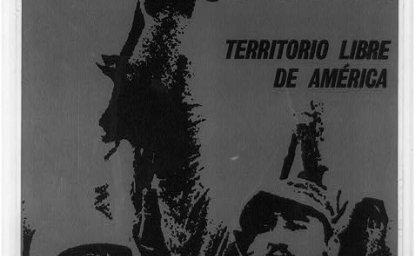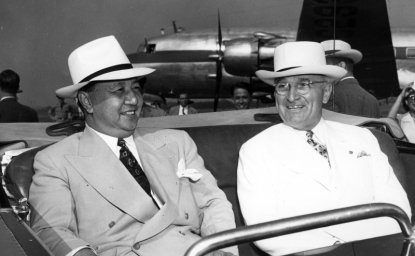Looking Back at the 1971 Uganda Coup
Just over fifty years ago, the East African nation of Uganda suffered a military coup, with an army general named Idi Amin Dada seizing control.

A blog of the History and Public Policy Program
Just over fifty years ago, the East African nation of Uganda suffered a military coup, with an army general named Idi Amin Dada seizing control.

Just over fifty years ago, the East African nation of Uganda suffered a military coup. On January 25, 1971, a Ugandan army general, Idi Amin Dada, seized control of the government from a civilian dictator, Milton Obote, who was blocked from returning home from a British Commonwealth meeting in Singapore.
To this day, the coup that brought Amin to power remains something of a puzzle. Diplomats said they saw little preparation for it. Some observers suspected an Israeli plot.
A former resident, a British colonial officer who insisted on anonymity during an interview with me, claimed his countrymen were “almost certainly” behind the overthrow, citing dictator Obote’s increasingly leftward policies.
As a journalist who visited Uganda in a brief reporting trip in November 1971, for years I remained alert for any evidence of American involvement in bringing this tyrant to power. I found absolutely none.
A veiled hint of American involvement – or acquiescence -- appears in a commentary on relations between US diplomats and their CIA counterparts in the field. In an essay published in 2000, former US Ambassador Robert Keeley does not identify Amin as the leader by name, but describes an African head of state who bears a resemblance. In one African country, Keeley wrote, ”ruled by one of the most brutal military dictators in recent African history, we had ‘enjoyed’ a direct relationship with the general before he came to power, as he had been a principal ‘asset’ of the CIA for some time.”
Speaking privately with several former diplomats who served in Uganda, I repeatedly heard them say they knew nothing to substantiate this conclusion.
What did become clear soon after the change of regime was that people were disappearing. In July 1971, two Americans went missing, Nicholas Stroh, a freelance newspaper reporter and heir to a Detroit family beer fortune, and Robert Siedle, a sociologist and lecturer at Makerere University in Kampala.
By late August, national security officers in the White House had all but concluded that the two men were murdered in a Ugandan Army barracks in Mbarara.
On August 24, 1971, Henry Kissinger advised President Nixon not to meet with Amin, who said he was planning a trip to Washington.
In a memo labelled secret, and declassified in 1989, Kissinger, the national security advisor, said: "Two American citizens apparently were recently killed by Amin's undisciplined troops, and it is inappropriate for you to agree to receive him while that matter is still in flux."
In November 1971, most of the world did not yet know that Amin had begun presiding over a national bloodbath that would connect him to the brutal murders of no fewer than 100,000 men, women, and children and possibly as many as 300,000 people.
"People were killed out of malice, revenge, envy or jealousy," said Wycliffe Kato, who was Uganda’s Director of Civil Aviation when he was pulled out of a line of passengers and arrested as he was about to board a flight at Entebbe Airport.
The killers, Kato wrote in a memoir, were teams from the State Research Bureau who "had a license to kill so long as an excuse – any excuse no matter how flimsy – could be found."
Their orders permitted them to operate without conducting investigations. "This meant that as soon as a report was received, a team was dispatched to kill whoever was reported on," wrote Kato.
The American Embassy staff in Kampala and its team in Washington were uncertain of Amin’s intentions.
"We were trying to figure out whether he was as crazy as he appeared to be," said David Shinn, the State Department desk officer for Uganda in 1971. "We ultimately concluded that he really was."
Not everyone who died was hunted down and murdered on direct orders from Amin. Stroh and Siedle, for example, appear to have fallen victim to a military officer acting on his own rage when they inquired about a reported mutiny.
The homicidal carnage in Amin’s Uganda was as much – or more -- a result of anarchy as it was of tyranny, argued Ali Mazrui, a Kenyan political scientist who lectured in Kampala at Makerere University.
“On balance,” he wrote in Idi Amin: Death-light of Africa, “many more people must have died, or been mutilated, in Uganda as a result of decentralized violence than in response to purposeful brutality by the regime.”
At peril in 1971 were 9.7 million Ugandans, a population that grew to nearly 12 million by the time of Amin's ouster in 1979.
Two melancholy facts remain today.
First, despite Idi Amin’s international reputation, he may not have been Uganda’s bloodiest tyrant.
In 1994, scholar A.B.K. Kasozi’s deeply researched account, The Social Origins of Violence in Uganda 1964-1985, reported that the total number of deaths for political motives during Amin’s reign reached as high as 300,000. These were dwarfed, however, by those recorded during two periods when Milton Obote ruled as president (from 1962 to 1971 and from 1980 to 1985). Estimates of murders during the Obote years were “…not less than 50,000 and could have been as high as one million.”
A second melancholy fact, the murders have not stopped. Death by staged auto accident and poisoning remain tools of political repression well into the 21st Century.
By one account, the Speaker of Uganda’s Parliament, Cerinah Nebanda, was murdered in 2012 by agents of the current president, Yoweri Museveni. She was “…poisoned, some of her parliamentary colleagues maintain, by Ugandan government operatives,” wrote Helen Epstein, a Bard College visiting professor who specializes in international public health reporting.
In 2021, Epstein reported continued violence against Museveni’s opponents during this January’s presidential election. In two days, she wrote, “at least fifty-four people – some (opposition candidate supporters), others bystanders – were shot dead by security forces or crushed by military vehicles…”
Why is it important to know the details of Uganda’s bloody struggle against its tyrants? The answer is that today, the lives of Uganda’s population – now grown to 44.2 million people – are still hostage to the homicidal whims of the political descendants of Milton Obote and Idi Amin.


A global leader in making key archival records accessible and fostering informed analysis, discussion, and debate on foreign policy, past and present. Read more


